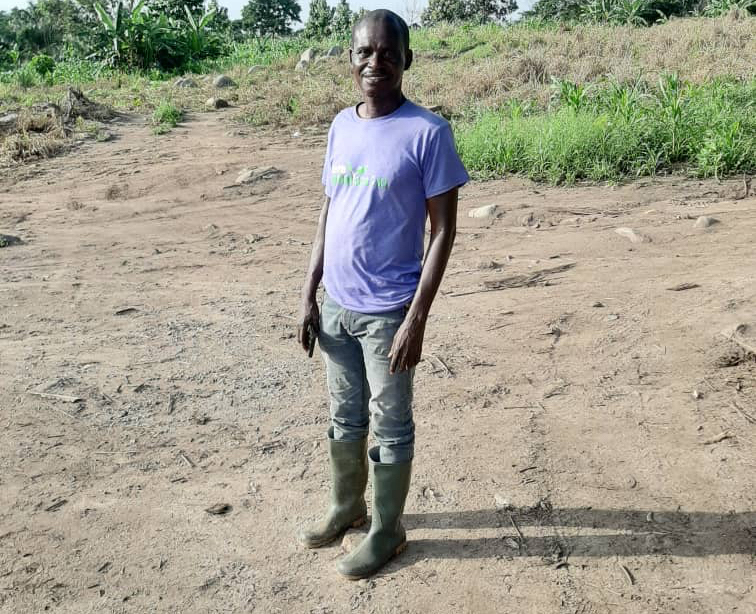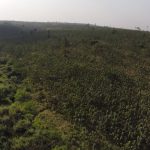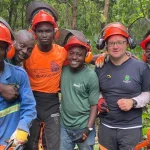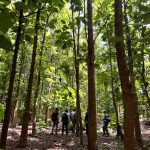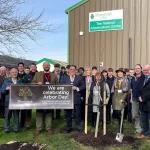My week as a Plantation Manager. Thomas Agyekum, everyone calls me Agyekum.
I am 53 years old and have been a professional forester all my adult life. The forest is where I feel most at home. I have 4 children who all live with me in Abofour. Originally, I come from Kwahu, this is in the Eastern Region of Ghana. Straight from school I went to the Ghana Forestry Commission forestry school. I trained as a forester and plantation manager. After many years working with Forestry Commission in the Afram Headwaters area I decided to go into the private sector. I joined Mere Plantations in 2017.
Compared to planting programmes with Forestry Commission, our programmes are quite intense. In the private sector, we always pay a lot more attention to the post planting management and maintenance. One eye is always on the next stage of the process. We run all aspects of our plantation business inhouse. Most people buy in young trees from nursery growers and plant out. We grow our own planting stock from seed. That way, we can be sure the genetic stock is of the best and most suitable quality.
Daily Diary
Monday
I went to the casual worker meeting point for a little before 08.00. We hire a lot of casual workers every day for specific tasks. This works better for us than full time employment for certain tasks, as the requirement changes with the seasons. It also proves better for the workers, as many have their own farms or small businesses. Working on day rates for Mere provides cash to supplement their farms and other interests. I allocated the first team to Compartment 13. This was for weeding between the young trees.
I had already placed contract weeding teams in Compartment 17. They do not get managed hour by hour. These are guys well known to us. We negotiate a fixed price with them, a timescale they must complete the work by, and they just get on with it. As the contract was coming to completion, I set off to inspect and discuss the next area with the team leader. From there I headed to Compartments 12 and 19 with 3 casual workers. We marked and staked the delineation of the 2 compartments. This was in preparation for the clearing teams to move in.
Next, I attended my daily meeting with John and a number of the team leaders to discuss progress of the day and agree the work plan for tomorrow. John is my opposite number; we divide the technical and management of the trees and stands between ourselves.
Tuesday
Normal morning allocation of the casual workers to the different stands for the day. Dispatched the teams to various areas within Compartment 13. I then headed to 17. Today I was accompanied by John and the General Manager. Did a final inspection of the weeding and signed the work off for payment. John and I split up to cover more ground. We conducted a visual inspection of established trees in the stand. We took some pictures for the head office in the UK.
I then headed to Compartment 14, met up with John again and we did a detailed inspection of the clearing and land preparation. At this time of year, a huge amount of effort goes into the land clearing, and soil preparation for the seasons planting. I was happy with what I saw, so I headed back to Abofour for a meeting with John, the GM and team leaders from all the different teams. This included the security and nursery teams. No major issues were reported. We collated the daily reports, staff hours for the casual workers and submitted the daily report for head office.
Wednesday
As usual, I oversaw the allocation of work for the casual workers. There were 84 workers, so split them into teams and dispatched them to the field. I met up with John and we headed off to Compartment 17. During the previous days’ inspection, we had both observed areas of young trees that were looking unwell. It was difficult to immediately tell if they were sick, diseased or just stressed. There had been no rain in this compartment for some time, but it is company policy to immediately act if we have any concerns. After a thorough inspection, and discussion we agreed there was an issue. The trees in a certain area looked sorry for themselves. We took more pictures and sent them to Accra. We then reported our suspicions to the Forestry Commission as is required of all foresters. Control and management of any potential issue is taken very serious by Ghana Forestry Commission.
I finished up the day with the usual meeting and handover. We filed the day sheets and reports to the GM and Accra. They onward file to the UK.
Thursday
Dealt with the usual morning routines. Signed on casuals and dispatched the teams to work areas. I then had a quick meeting to allocate duties between John and I. John set off for the various work areas, I headed off to Compartment 17. Captain Forjoe had travelled up from Accra to inspect the issues we had reported in Compartment 17. He had agreed a plan for assessment and action with the UK overnight. This time of year is very hot, and extremely humid. It was cooler this morning, there had been a lot of rain overnight. When we arrived at Compartment 17 it was mid morning. The affected trees were looking quite a bit better, the difference was clear. It appears there was some form of contaminant that the trees had broken into. This, although not common does happen. Once you get heavy rain, whatever has caused the problem becomes diluted and the trees natural instinct kicks in to take in a lot of water.
We were all happy to see the return to health of the stand. We agreed a 30-day monitoring plan for the stand. As all was well, we decided to head to Compartment 14. Captain wanted to check the status of the land preparation, and also to find out why we were suffering so much downtime from broken down bulldozers. Lengthy discussions took place with the dozer driver. Captain decided to bring in an extra machine as he wasn’t happy. If we do not have enough land prepared when the trees are ready for planting, we can have a big problem. We must plant when the rain is optimum, delays risk the establishment. We then headed to the nursery for an inspection of the 2020 planting stock.
Friday
I went to FORIG to personally deliver the report on the tree health situation. I know the team there; it was nice to see old friends. We discussed the trees and agreed we would touch base in a few weeks unless anything deteriorated. I then headed to Offinso to the district office of the Forestry Commission plantation division. I wanted to check on the status of the cartographers mapping of Compartments 80 and 100. They were all on track. I then headed back to Abofour in time for the end of week meeting of department heads and team leaders. We reviewed the week, completed the reports and agreed the plan for next week.

